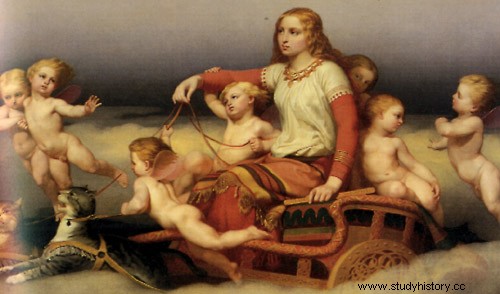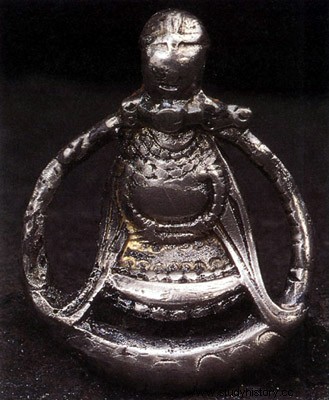No doubt:the lady. Goddess vane.

Freyja is generally considered the goddess of earth and fertility in Norse mythology. Freyja means lady or "sovereign" in Old Norse (cf. fru or Frau in Scandinavian or German). There is no source indicating that she was called to bring fertility to the fields and to the women; she was the goddess of intimacy. She was also the goddess of love, sex, war, prophecy, and human attraction; she therefore became one of the most popular goddesses. She can be considered the equivalent of Venus and Aphrodite. It is likely that she is the most direct mythological descendant of Nerthus.
Freyja is a Vane, goddess of love in Norse mythology, she is beautiful, has blue eyes and golden hair. She is the daughter of Njörd, and the twin sister of Freyr. His daughter is called Hnoss.
Odr, Freyja's husband, "a man who travels far", is probably a hypostasis of Odin or Odin himself, because he disappears shortly after their marriage. After Odr disappeared, Freyja wept tears of red gold that turned to amber when they fell into the sea. She is sometimes confused with Frigg, wife of Odin, goddess of marriage.
Like Odin, she receives in her Sessrumne mansion in Folkvang half of the warriors who died in battle, whom she will guide into battle on the day of Ragnarök. She is considered the first among the Valkyries.
To explain this sharing of the Einherjar between Odin and Freyja, some oral transmissions (Óðal Property) explain that the warriors devolved to Odin are those among them who dedicate their existence to war and battles that are called offensive. The warriors devolved to Freyja are those of them who fight to protect their families, their clans and their property, which are called the defensive. Historian Else Roesdahl noted that in burials containing weapons:in those in Norway the warriors had (defensive) shields, and in Denmark they only had their attacking (offensive) weapons [1]. However, another theory advances the idea that the mounds of Norway would be adorned with shields to show that the deceased died defending his homeland, his kingdom. While the Danish mounds would be adorned with weapons to show that the deceased had died enlarging his kingdom, but these speculative theories, like so many others, are far from completely elucidating this mystery.
His chariot is pulled by two cats the size of lions. Her magic necklace, the Brísingar necklace, makes her irresistible. She loves singing and has many lovers.
Unlike many other gods, she is loved by the giants and many of them covet her.

